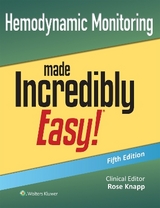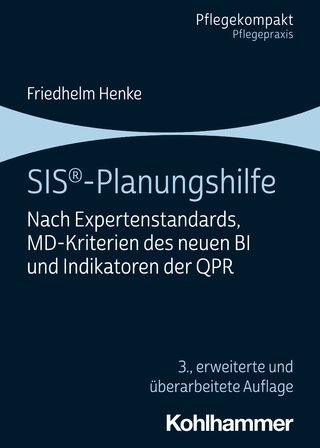
Hemodynamic Monitoring Made Incredibly Visual
Seiten
2020
|
4th edition
Wolters Kluwer Health (Verlag)
978-1-9751-4829-4 (ISBN)
Wolters Kluwer Health (Verlag)
978-1-9751-4829-4 (ISBN)
Zu diesem Artikel existiert eine Nachauflage
Selected as a Doody's Core Title for 2022 and 2023!
Build a solid knowledge base in hemodynamic nursing skills, with the newly updated Hemodynamic Monitoring Made Incredibly Visual!®, 4th Edition.
Full of colorful images that illustrate monitoring concepts and processes, this concise, enjoyable guide sorts through the complexities of hemodynamics and clarifies them in easy-to-follow ways. Grasp the structures and functions of pulmonary and cardiac systems and the vital skills of hemodynamics, with this vital reference—a must-have for all nursing students, new nurses, and nurses returning to critical care.
Get clear, concise direction on the concepts, devices, and nursing skills used in hemodynamic monitoring:
NEW and updated content, photos and graphics that demonstrate nursing skills and responsibilities
Hundreds of colorful images that guide you through the ins and outs of hemodynamics – detailed photos, diagrams, charts and other visual aids that clarify cardiopulmonary anatomy and physiology
Illustrates vital practice issues, such as how to confirm the lungs are getting enough oxygen, and how well the heart is pumping — explains and reinforces key concepts in easy-to-remember ways
Explains the fundamentals and current best practices in hemodynamic monitoring in easy-to-retain terms
Ideal for visual learners –images demonstrate step-by-step, expert guidance on monitoring skills, physiology and devices:
Understanding cardiopulmonary anatomy and physiology
Understanding a pressure monitoring system
Vascular access
Pressure monitoring – arterial, central venous, and pulmonary artery pressure monitoring
Cardiac output monitoring
Tissue oxygenation monitoring
Minimally invasive hemodynamic monitoring
Circulatory assist devices
Step-by-step guidance on thermodilution methods, analyzing thermodilution curves, measuring cardiac function and output, maintaining artery catheters, and more
Ideal on-the-spot reference and review for nursing students and new nurses – addresses the physiology behind each learning objective and provides vital nursing considerations
Chapter features:
On the level – defines normal and abnormal pressure readings for different patient conditions
Q&A – illustrated riddles, diagrams, and questions and answers at the end of each chapter that help you fully integrate new knowledge
Matchmaker – matching terms and conditions to their correct definition
Memory board – learning aids and memory cues that help you retain important definitions and processes
Ride the wave – explains the actions of waveforms, including how to recognize abnormal waveforms
“Nurse Joy and Jake” – expert insights and encouraging advice
About the Clinical Editor
Rose Knapp, DNP, RN, APN-BC, is an Acute Care Nurse Practitioner, and Associate Graduate Faculty and MSN Program Director/APN Program Coordinator at the Marjorie K. Unterberg School of Nursing and Health Studies at Monmouth University in West Long Branch, New Jersey
Build a solid knowledge base in hemodynamic nursing skills, with the newly updated Hemodynamic Monitoring Made Incredibly Visual!®, 4th Edition.
Full of colorful images that illustrate monitoring concepts and processes, this concise, enjoyable guide sorts through the complexities of hemodynamics and clarifies them in easy-to-follow ways. Grasp the structures and functions of pulmonary and cardiac systems and the vital skills of hemodynamics, with this vital reference—a must-have for all nursing students, new nurses, and nurses returning to critical care.
Get clear, concise direction on the concepts, devices, and nursing skills used in hemodynamic monitoring:
NEW and updated content, photos and graphics that demonstrate nursing skills and responsibilities
Hundreds of colorful images that guide you through the ins and outs of hemodynamics – detailed photos, diagrams, charts and other visual aids that clarify cardiopulmonary anatomy and physiology
Illustrates vital practice issues, such as how to confirm the lungs are getting enough oxygen, and how well the heart is pumping — explains and reinforces key concepts in easy-to-remember ways
Explains the fundamentals and current best practices in hemodynamic monitoring in easy-to-retain terms
Ideal for visual learners –images demonstrate step-by-step, expert guidance on monitoring skills, physiology and devices:
Understanding cardiopulmonary anatomy and physiology
Understanding a pressure monitoring system
Vascular access
Pressure monitoring – arterial, central venous, and pulmonary artery pressure monitoring
Cardiac output monitoring
Tissue oxygenation monitoring
Minimally invasive hemodynamic monitoring
Circulatory assist devices
Step-by-step guidance on thermodilution methods, analyzing thermodilution curves, measuring cardiac function and output, maintaining artery catheters, and more
Ideal on-the-spot reference and review for nursing students and new nurses – addresses the physiology behind each learning objective and provides vital nursing considerations
Chapter features:
On the level – defines normal and abnormal pressure readings for different patient conditions
Q&A – illustrated riddles, diagrams, and questions and answers at the end of each chapter that help you fully integrate new knowledge
Matchmaker – matching terms and conditions to their correct definition
Memory board – learning aids and memory cues that help you retain important definitions and processes
Ride the wave – explains the actions of waveforms, including how to recognize abnormal waveforms
“Nurse Joy and Jake” – expert insights and encouraging advice
About the Clinical Editor
Rose Knapp, DNP, RN, APN-BC, is an Acute Care Nurse Practitioner, and Associate Graduate Faculty and MSN Program Director/APN Program Coordinator at the Marjorie K. Unterberg School of Nursing and Health Studies at Monmouth University in West Long Branch, New Jersey
Rose Knapp, DNP, RN, APN-C, has been a practicing nurse practitioner and clinical preceptor for the past 24 years with experience in the emergency department, urgent care, and family practice. She is the MSN program director and an associate graduate professor at Monmouth University.
1. Cardiopulmonary anatomy and physiology
2. Understanding a pressure monitoring system
3. Vascular access
4. Arterial pressure monitoring
5. Central venous pressure monitoring
6. Pulmonary artery pressure monitoring
7. Cardiac output monitoring
8. Tissue oxygenation monitoring
9. Minimally invasive hemodynamic monitoring
10. Circulatory assist devices
Index
| Erscheinungsdatum | 13.09.2020 |
|---|---|
| Reihe/Serie | Incredibly Easy! Series® |
| Zusatzinfo | 310 |
| Sprache | englisch |
| Maße | 178 x 229 mm |
| Gewicht | 272 g |
| Themenwelt | Medizin / Pharmazie ► Pflege |
| ISBN-10 | 1-9751-4829-0 / 1975148290 |
| ISBN-13 | 978-1-9751-4829-4 / 9781975148294 |
| Zustand | Neuware |
| Informationen gemäß Produktsicherheitsverordnung (GPSR) | |
| Haben Sie eine Frage zum Produkt? |
Mehr entdecken
aus dem Bereich
aus dem Bereich
Anregungen für kreatives Handeln
Buch | Softcover (2023)
Kohlhammer (Verlag)
24,00 €
nach Expertenstandards, MD-Kriterien des neuen BI und Indikatoren der …
Buch | Softcover (2023)
Kohlhammer (Verlag)
29,00 €
Buch | Spiralbindung (2024)
Urban & Fischer in Elsevier (Verlag)
19,00 €



